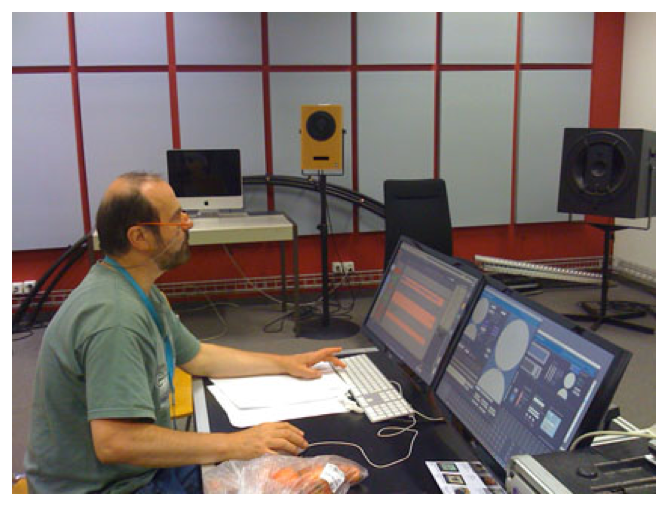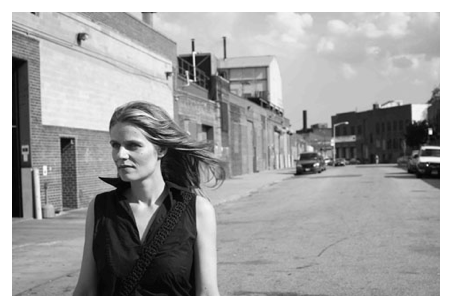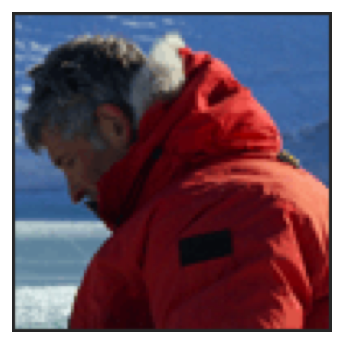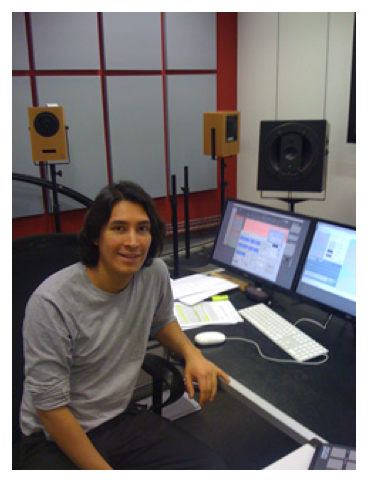| 18 |
2011 |
Helmut Zapf (BRD) Geboren am 4.3.1956 in Rauschengesees (Thüringen). Ersten Klavier - und Orgelunterricht erhielt er beim Ortspfarrer Gerhard Voltz. 1974 begann er Studium der Kirchenmusik in Eisenach und Halle/Saale (Orgel bei Gottfried Preller und Hans-Günter Wauer, Tonsatz bei Johannes Petzold) welches er 1979 beendete. Während dieser Zeit besuchte er regelmäßig den Ferienkurs für Neue Musik in Gera, besonders die Kompositionskurse bei Paul-H. Dittrich und die Elektronikkurse bei Lothar Voigtländer. Von 1979 – 82 arbeitete er als Kantor und Organist an der Stadtkirche in Eisenberg (Thüringen). 1982 wurde Helmut Zapf Meisterschüler an der Akademie der Künste der DDR in Berlin bei Prof. Georg Katzer und studierte dort mit ihm, leider mit der Unterbrechung als Bausoldat (Waffenverweigerung), bis 1986. Seitdem arbeitet er als freiberuflicher Komponist und lebt in Panketal bei Berlin. Im Lehrauftrag unterrichtet er inden Fächern Tonsatz, Kontrapunkt und Kompostion an der HfM Hanns Eisler und an den Musikschulen Kreuzberg und Neukölln. 1992 gründete er in seiner Kirchgemeinde gemeinsam mit seiner Frau die Zepernicker RANDFESTSPIELE, ein Konzertwochenende für Neue Musik. Im Rahmen der Kreuzberger Klangwerkstatt gründete Helmut Zapf 1994 das Ensmbles JungeMusik Berlin, welches heute einen städigen Bestandteil als Festivalensemble der Klangwerkstatt und der Randfestspiele darstellt. Folgende Stipendien und Preise er hielt Helmut Zapf : 1987 Hanns-Eisler Preis von Radio DDR 1987 Valentini Bucchi Preis der Stadt Rom 1992 Kunstförderpreis der Akademie der Künste Berlin / Brandenburg 1994 Ehrengast der Villa Massimo Rom (Deusche Akademie) 1997 Arbeitsstipendium an der Cite´ des Arts (Paris) 2000 Arbeitsaufenthalt im Künstlerhof Schreyahn (Niedersachsen) 2003 1. Preis beim internationalen Kompositionswettbewerb der Thüringisch/Hessischen SparkassenStiftung für die Komposition « Frühling » für Harfe und Akkordeon 2005 Stipendiat der AdK Berlin an der Villa Serpentara in Olevano Romano 2008 Stipendiat an der Casa Baldi in Olevano Romano 2009 September, Stipendium im Künstlerhaus Lukas in Ahrenshop 2011 August, September composer in residence des ICST Zürich ICST composer in residence 22.08 bis 11.09.2011 Realisation einer Ambisonic-Komposition im Auftrag des ICST der Hochschule der Künste Zürich für Zuspiel, Live-Elektronik und Gitarre, Titel: "... wie im Himmel, so auf Erden. ..." mehr unter : www.helmutzapf.com und www.randspiele.de ::: Katharina Rosenberger (CH)  Katharina Rosenberger, born in Zurich, holds a Master of Music from the Royal Academy of Music in London and graduated in 2009 with a Doctor of Musical Arts in Composition from Columbia University. Principal teachers include Tristan Murail and Michael Finnissy. Since Fall 2008, Katharina holds the position of Assistant Professor in Composition at the Department of Music, University of California, San Diego. Much of her work manifests in an interdisciplinary context and is bound to confront traditional performance practice in terms of how sound is produced, heard and seen. She often works in a collaborative setting and links her music (for acoustic and electronic mediums) and installations with the theatre, video art and modern dance.Recently, her work has been featured at the Shanghai New Music Week 2009, the Shanghai International Electro-Acoustic Music Festival, and the October Contemporary in Hong Kong, the Weimarer Frühlingstage, Germany, and the Festival Archipel, Switzerland. Previous festival participation include the Festival für Neue Musik, Bamberg, Zürcher Theaterspektakel, Festival La Bâtie – Festival de Genève, Schweizer Tonkünstlerfest Switzerland, Festival Les Musiques, Marseille, Zoo Bizzarre Bordeaux, Centre Acanthes at the Avignon Festival, France, Bath Festival, UK, New Media Art Festival, Yerevan, Armenia, International Festival of Modern Arts, Odessa, Ukraine and the Festival “atélier trideni plus”, Prague, Czech Republic. Rosenberger maintains an active musical live on the East and West Cost of America and throughout Europe. Awards include the Reid Hall and Camargo Foundation Fellowships, the 2007 Pro Helvetia composition commission, 2005 “Mediaprojects Award”/ Projekt Sitemapping of the Swiss Federal Agency (OFC), and the Landis&Gyr London Studio Prize. In 2005 Katharina Rosenberger was composer in residence with the Orchestre de Nîmes, Nîmes, France. ICST composer in residence 22.08 bis 11.09.2011 nodes (2011) "nodes" is a multi-channel work composed specifically for the SABRe instrument and to work within the ambisonic environment. In choosing to work spatially I endeavor to link more clearly the position of the performer, musical gesture and his or her status as an imminent sound source with the distribution of the electronic and processed sound within the performance space. Here, the interpretation of a "node"—as a point at which pathways intersect—forms the basis of my spatial thinking. In the context of this project, I like to think of sound as a concrete element that can be projected into space like a beam of light. At points where different beams meet, a "sonic node" is provoked. Such nodes will be constituted by the blend of different musical material crossing at a given location within the ambisonic field. These techniques are a means to afford the listener an easier distinction of singular musical incidents within a dense and active sonic construct. With the application of the sensors, as SABRe suggests, the performer will be able to control the production and articulation of electronic sound with the natural gestures of clarinet performance practices. Within this framework sound becomes uniquely malleable in a most intuitive and musical manner. www.krosenberger.ch ::: Philip Samartzis (AUS)  ICST Artist Residency 26.06.2011 - 17.07.2011 Philip Samartzis complete four projects based on field work in South Africa, Central Australia and Eastern Antarctica. - MFSA-RADAR (43') - Crush-Grind (45') - Tract (49') - Captured-Space (45') Philip Samartzis is Coordinator of Sound in the School of Art - RMIT University, where he teaches courses in Sound Culture, and Immersive Environments within the fine art degree. Philip researches in the areas of sound art, acoustic ecology and sound spatialization, and is currently chief investigator on two Australia Research Council funded projects, Designing Sound for Health and Wellbeing; and Spatial Dialgoues: Public Art and Climate Change. His PhD, Surround Sound in Installation Art, examined the place of sound in contemporary art practice through a range of site determined sound art projects. In 2010 Philip was awarded fellowships by the Australia Council for the Arts, and the Australian Antarctic Division to document the effects of extreme climate and weather events on the human condition at Davis Station in Eastern Antarctica. Philip has performed and exhibited widely including presentations at The Cartier Foundation, Paris (2001); The Andy Warhol Museum, Pittsburgh (2002); The Mori Arts Centre, Tokyo (2003); The National Center for Contemporary Art, Moscow (2009); and The South African National Museum, Cape Town (2010). He has curated five Immersion festivals focusing on the theory and practice of sound spatialisation, as well as Variable Resistance, a series of international sound art presentations for the Australian Centre for Contemporary Art, Melbourne (2001), the San Francisco Museum of Modern Art (2002) and the Podewil Art Centre, Berlin (2003). Philip has also published five solo compact discs, Residue (1998), Windmills Bordered By Nothingness (1999), Mort aux Vaches (2003), Soft and Loud (2004) & Unheard Spaces (2006) and has performed and recorded with leading international improvisers and musicians including Sachiko M, Seiichi Yamamoto, Gunter Müller, Voice Crack, Keiji Haino, Oren Ambarchi, Reinhold Friedl, Michael Vorfeld, Eric La Casa and Jean-Luc Guionnet. Philip uses field recordings of natural and constructed environments as his primary material to render densities of space and discrete zones of aural experience, which are arranged and mixed to reflect the acoustic and spatial complexities of everyday sound fields. He draws on a range of practices ranging from acoustic ecology and bioacoustics to musique concrète and sound art to arrive at compositions that highlight the pervasive nature of sound and the myriad ways in which it informs and influences our daily experiences. To emphasize this Philip designs his compositions for multi-channel surround sound systems that afford immersive and tactile listening experiences to demonstrate the transformational qualities inherent in sounds familiar and strange. ::: ALEJANDRO MONTES DE OCA TORRES (Mexico)  31.01.2011 - 20.02.2011 Alejandro Montes de Oca is a Mexican composer, performer and sound artist. Inspired by the physical materiality of sound, our contemporary soundscape and different time perceptions, he focuses on organizing sounds in space and time with the use of self-made electroacoustic instruments and applications. He deals in the compositional process with the new perspectives given by the combination of electroacoustic music with theatrical/visual elements. He explores different ways to create space in a music composition through the use of speaker feedback with granular synthesis and temporal decorrelation of waveforms. The creation of sound objects that works as a live source in a music composition or in a sound installation is a topic that has attract his work and imagination. Drawing from her background in guitar performance and music composition, he works nowadays as a live electronics performer. He plays with CoCo duro dúo together with the Colombian musician Alejandro Olarte, with the main interest in exploring live electronics, composition and improvisation. His music has been presented in different festivals and concerts in Europe and America. He has got commissions by the Instrumenta Festival (Mexico), IMEB (France), CDMC (Spain) and ICST (Switzerland), as well as scholarships from the UNESCO-Aschberg, FONCA, the Cultural Minister of Spain and the Swedish Performing Rights Society (STIM). In 2009, he was one of the prizewinners of the 10th Electroacoustic Composition Competition Musica Viva with his piece “Cracked voices”. Alejandro received a bachelor degree in guitar performance from the Superior School of Music, Mexico City, and masters degree in electroacoustic composition from the Royal School of Music in Stockholm. He studied computer-music and media electronics in Vienna and he followed the ECMCT (European Course for Musical Composition with Technologies), Track A Helsinki-Barcelona program. http://www.allmonts.com/ New piece was realized at the ICST: "Guitarrón_17" duration ~18' |
||||